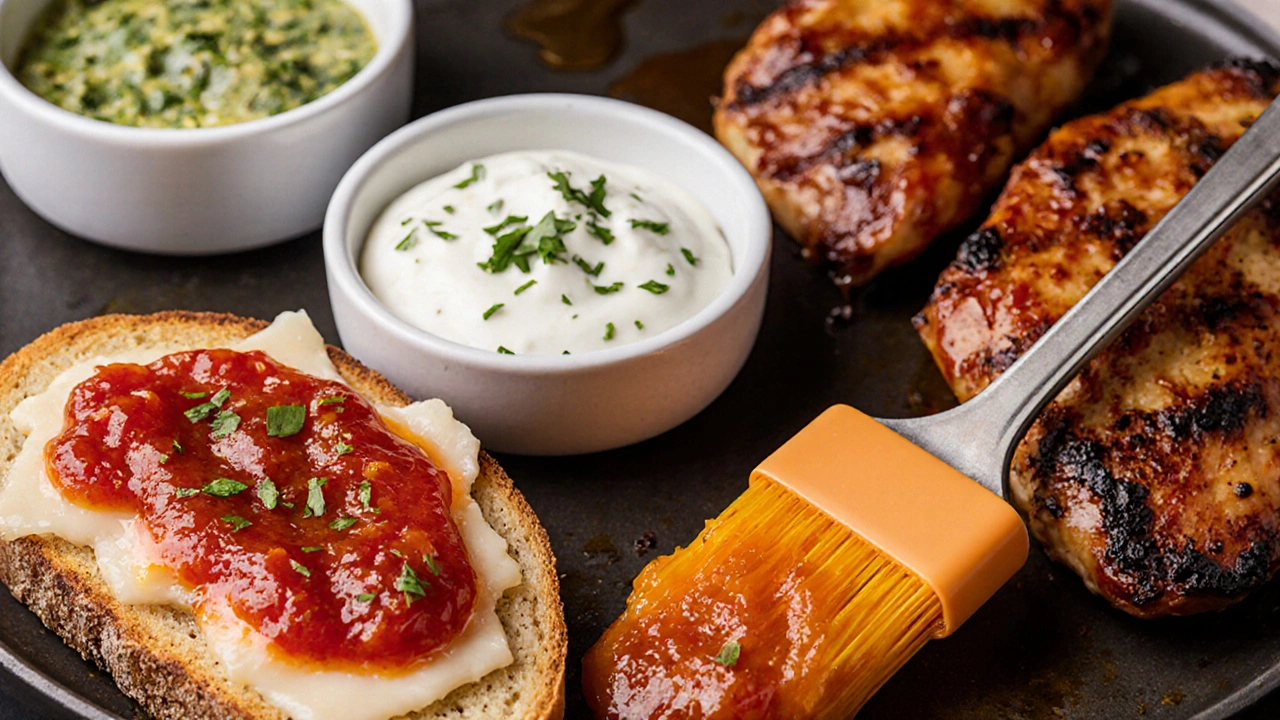Chutney Translator
Choose Your Chutney Type
Choose English Descriptor
When you hear the word chutney is a tangy, sweet‑spicy condiment that originated in the Indian subcontinent, you might wonder if there’s a plain English equivalent. Short answer: there isn’t a single exact match, but a handful of familiar words-relish, pickle, and condiment-capture parts of its meaning. This guide breaks down the history, the linguistic roots, and the practical ways you can describe chutney in everyday English.
What "chutney" Actually Means
The word chutney comes from the Hindi chatni, which itself is derived from the Sanskrit cāṭa‑nī meaning “to lick.” Historically it described a fresh, chopped mixture of herbs, fruits, and spices that could be cooked down or left raw. Early Indian chutneys were often made with cilantro, mint, and souring agents like tamarind or lime.
Why English Doesn’t Have a One‑Word Match
English already uses the word “condiment” for any sauce or garnish that adds flavor. But “condiment” is too broad; it lumps together mustard, ketchup, soy sauce, and chutney alike. The closest narrow terms are:
- Relish - usually a finely chopped, pickled mixture, often cucumber‑based.
- Pickle - fruit or veg preserved in brine or vinegar, sometimes sweetened.
Both miss the sweet‑spicy profile that defines many chutneys. That’s why culinary writers often keep the original word and add a brief description, e.g., “Mango chutney - a sweet‑spicy Indian relish.”
How Chutney Traveled to the English Language
During the 17th and 18th centuries, the British Empire imported Indian foods to its home islands. Early British cookbooks listed “chutney” alongside “curry” as exotic accompaniments. By the Victorian era, chutney had become a staple on the British dinner table, especially the famous Mrs. Beeton's recipe for “Mango Chutney.” The British adaptation often added sugar and vinegar, turning the fresh Indian version into a jam‑like preserve. This colonial history explains why the word stayed in English rather than being translated.

Different Types of Chutney and Their English Descriptions
Not all chutneys look the same. Below is a quick cheat‑sheet that pairs popular Indian varieties with the nearest English term you can use in conversation.
| Indian Chutney | Main Ingredients | Closest English Word | Typical Use |
|---|---|---|---|
| Mango | Ripe mango, sugar, vinegar, chilies | Sweet‑spicy relish | Barbecue glaze, cheese platter |
| Coriander‑Mint | Cilantro, mint, green chilies, lemon | Fresh herb salsa | Dosa topping, sandwich spread |
| Tamarind | Tamarind pulp, jaggery, spices | Sour‑sweet dip | Indian street snacks, grilled meats |
| Tomato | Tomatoes, ginger, garlic, mustard seeds | Spicy fruit preserve | Breakfast toast, burger sauce |
How to Explain Chutney in Everyday English
When you need to describe chutney to someone who’s never tasted it, try this three‑step formula:
- Flavor profile: say “sweet‑spicy” or “tangy and nutty.”
- Texture: note whether it’s “smooth like jam” or “chunky like salsa.”
- Typical pairing: mention it goes well with “grilled chicken, fish, or flatbreads.”
Example: “Mango chutney is a sweet‑spicy, jam‑like sauce that pairs perfectly with roasted pork.” This sentence gives enough context for most English speakers to picture the condiment without needing a direct translation.
Common Misunderstandings About Chutney
Many people conflate chutney with pickle because both can involve vinegar. The key difference lies in the balance of sweet versus sour. Pickles lean heavily toward acidity, while chutneys balance sweetness, heat, and sometimes fruitiness. Another mix‑up is with relish, which is usually less complex in spice levels. Knowing these nuances helps you pick the right word in a recipe description.

Using Chutney in Western Cooking
Chefs outside India have embraced chutney as a versatile garnish. Here are three popular ways to incorporate it without sounding exotic:
- Swirl a spoonful of mango relish into a BBQ sauce for an unexpected tang.
- Mix cilantro‑mint chutney with Greek yogurt to create a refreshing dip for vegetable crudités.
- Spread a thin layer of tomato chutney on a toasted baguette and top with melted cheese for a quick open‑face sandwich.
In each case, you can call the chutney a “relish” or “sauce” based on the dish’s context, keeping the description clear for Western diners.
Quick Reference: The One‑Word English Choice
If you must pick a single English word, relish is the safest bet. It conveys the idea of a flavorful, often chunky accompaniment, and it’s familiar to most English speakers. However, remember to add a short clarifier-“Indian‑style relish” or “sweet‑spicy relish”-to preserve the unique character of chutney.
Frequently Asked Questions
Is chutney the same as pickle?
No. Pickle focuses on preserving vegetables or fruits in a brine or vinegar solution, emphasizing sourness. Chutney balances sweet, sour, and spicy notes, and often includes fruit or herbs for added flavor.
Can I call chutney a sauce?
Yes, especially when the chutney is smooth and pourable, like a mango or tomato version. Calling it a “sauce” works well for plating or cooking applications.
What’s the best English phrase for a fresh herb chutney?
“Fresh herb relish” or “herb salsa” both convey the uncooked, bright nature of cilantro‑mint chutney.
Are there any regional English terms for chutney?
In the UK, people often just say “chutney” because the word is well‑known. In the US, “relish” is the closest everyday term.
How do I store homemade chutney?
Keep it in a sterilized glass jar, cover with a thin layer of oil or vinegar, and refrigerate. Most chutneys stay good for 2‑3 weeks; some high‑sugar varieties can last months.
